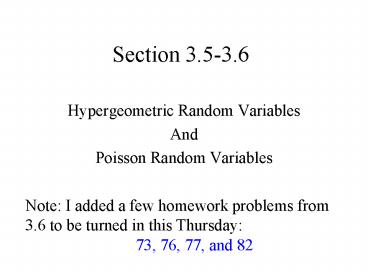Hypergeometric Random Variables PowerPoint PPT Presentation
1 / 13
Title: Hypergeometric Random Variables
1
Section 3.5-3.6
- Hypergeometric Random Variables
- And
- Poisson Random Variables
Note I added a few homework problems from 3.6 to
be turned in this Thursday 73, 76, 77, and
82
2
Hypergeometric Random Variables
- Let X be the number of successes obtained when
sampling from a population of size N with M
successes and N-M failures. X is a hypergeometric
r.v. - What are the possible values of X?
- What is the pmf of X?
- Note instead of p(x), pmf is labeled h(xn,M,N).
3
Mean and Variance
- The mean of a hypergeometric r.v. is
- The variance is
4
Example
- 8 women and 10 men have applied for the same job.
The company will do 6 interviews (randomly
chosen) per day for three days. - What is the probability that no women are
interviewed on the first day? - What is the probabiity that at least 2 women are
interviewed on the first day? - What is the expected number and the variance of
the number of women that will be interviewed on
the first day?
5
Relationship between binomial and hypergeometric.
- One application of binomial is sampling from
finite population of S and F with replacement. - While the hypergeometric is sampling w/o
replacement.
6
Recall HW problem
- 10000 boards, 2000 of which are green. Sample 2
boards . Are the events 1st board is green and
second board is green independent if sampling
is done - w/ replacement
- w/o replacement
- Suppose instead there are only 10 boards, 2 of
which are green and the sampling is done - w/replacement.
- W/o replacement
7
Compare mean and variance.
- Set pM/N. Sample size of n.
- What is the expected number of successes if
sampling is done with replacement? Without
replacement? - What is the variance of the number of successes
if sampling is done with replacement? Without
replacement?
8
Poisson Random Variable
- Class handout.
- The Poisson r.v is a discrete r.v. with possible
outcomes 0,1,2, and pmf - The mean is l and the variance is l.
9
Poisson Random Variable
- The cdf is tabulated for common values of l in
Table A.2, page 721. A piece is given here.
10
Two applications of Poisson
- The binomial (n,p) pmf and the Poisson(np) pmf
are approximately equal when n is large and p is
small. - Ex. The number of three letter words in a string
of 100 randomly generated letters. - The number of occurrence in a fixed time
interval. (Counting occurrences, but do not have
distinct trials.) - The number of calls received by a 911 operator
during a 1 hour time period. - In this case, l is the expected number of
occurrence in the time interval. l is sometimes
called the rate.
11
Example
- The number of tickets issued by a meter reader
for parking-meter violations during a particular
hour can be modeled by a Poisson r.v. with rate
parameter of 4 per hour. - What is the probability that exactly four tickets
are given out during a particular hour? - What is the probability that at least four
tickets are given out during a particular hour?
12
Poisson Process
- The number of occurrences
- in a interval of length 1 is Poisson with
parameter l. - in an interval of length t is Poisson with
parameter l t. - in non-overlapping intervals are independent.
- In the previous example, suppose that the number
of tickets issued follows a Poisson process. - How many tickets do you expect to be given during
a 45 minute time interval? - What is the probability that at least three
tickets are given out in a 45 minute time
interval?
13
Summary Families of Discrete Random Variables
- You should know and/or be able to derive pmfs of
Binomial and Hypergeometric random variables. You
should know the pmf of a Poisson r.v. You should
know when each of these probability models is
apllicable. - You should know mean and variance of binomial,
hypergeometric, and Poisson r.v.s - You should be able to use tabulated cdf for
Binomial and Poisson random variables. - You should know when the hypergeometric can be
approximated by a binomial and when the binomial
can be approximated by the Poisson - You are not responsible for the negative binomial
r.v. described in section 3.5

